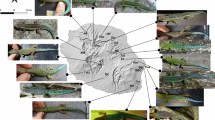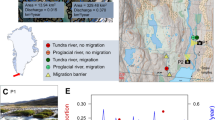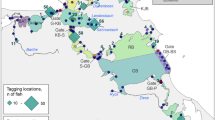Abstract
Eutrophication generally favours the growth of cyanobacteria over eukaryotic green algae in freshwater lakes. Cyanobacteria constitute a poor food source for the waterflea Daphnia, an important primary consumer of phytoplankton in lakes. While it is known that some Daphnia species are adapted to eutrophic conditions and can cope with cyanobacteria in their diet, it is less known whether cyanobacterial community composition can influence Daphnia population structure in lakes. We studied the variation in genetic diversity of Daphnia resting eggs and cyanobacterial DNA preserved in sediment cores from three European lakes impacted by eutrophication. Our retrospective analysis confirms that D. galeata invaded the two pre-alpine lakes around the middle of the twentieth century, hybridized with and became dominant over D. longispina. This coincides with the presence in all lakes and the increase in the proportion of colonial and filamentous cyanobacteria in the pre-alpine lakes. The recent re-oligotrophication of the lakes did not reverse the cyanobacterial and Daphnia assemblages to their pre-eutrophication composition and genetic structure, suggesting that both changed irreversibly due to anthropogenic influence on the ecosystems. Genetic analyses applied to lake sedimentary archives have the potential to unveil how different compartments of the food web covary in a changing environment.





Similar content being viewed by others
References
Agawin, N. S. R., C. M. Duarte & S. Agustí, 2000. Nutrient and temperature control of the contribution of picoplankton to phytoplankton biomass and production. Limnology and Oceanography 45: 591–600.
Alberto, F., 2009. MsatAllele-1.0: an R package to visualize the binning of microsatellite alleles. Journal of Heredity 100(3): 394–397.
Alric, B., M. Möst, I. Domaizon, C. Pignol, P. Spaak & M. E. Perga, 2016. Local human pressures influence gene flow in a hybridizing Daphnia species complex. Journal of Evolutionary Biology 29: 720–735.
Anneville, O., S. Gammeter & D. Straile, 2005. Phosphorus decrease and climate variability: mediators of synchrony in phytoplankton changes among European peri-alpine lakes. Freshwater Biology 50(10): 1731–1746.
Benzie, J., 2005. Cladocera: The Genus Daphnia (including Daphniopsis), Vol. 21. Kenobi Productions, Backhuys Publishers, Leiden.
Bissett, A., J. A. E. Gibson, S. N. Jarman, K. M. Swadling & L. Cromer, 2005. Isolation, amplification, and identification of ancient copepod DNA from lake sediments. Limnology and Oceanography: Methods 3: 533–542.
Boere, A. C., J. S. S. Damsté, W. I. C. Rijpstra, J. K. Volkman & M. J. Coolen, 2011. Source-specific variability in post-depositional DNA preservation with potential implications for DNA based paleoecological records. Organic Geochemistry 42(10): 1216–1225.
Bohonak, A. J. & D. G. Jenkins, 2003. Ecological and evolutionary significance of dispersal by freshwater invertebrates. Ecology Letters 6(8): 783–796.
Brede, N., A. Thielsch, C. Sandrock, P. Spaak, B. Keller, B. Streit & K. Schwenk, 2006. Microsatellite markers for European Daphnia. Molecular Ecology Notes 6(2): 536–539.
Brede, N., C. Sandrock, D. Straile, T. Jankowski, P. Spaak, B. Streit & K. Schwenk, 2009. The impact of human-made ecological changes on the genetic architecture of Daphnia species. Proceedings of the National Academy of Sciences of the United States of America 106: 4758–4763.
Bürgi, H. R. & C. Jolidon, 1998. 10 jahre seesanierung Hallwilersee, Die Reaktion des Planktons. Wasser Energie Luft 90: 109–116.
Bürgi, H. R., H. Bührer & B. Keller, 2003. Long-term changes in functional properties and biodiversity of plankton in lake Greifensee (Switzerland) in response to phosphorus reduction. Aquatic Ecosystem Health & Management 6(2): 147–158.
Callieri, C., 2007. Picophytoplankton in freshwater ecosystems: the importance of small-sized phototrophs. Freshwater Reviews 1: 1–28 [available on internet http://www.bioone.org/doi/abs/10.1608/FRJ-1.1.1].
Capo, E., D. Debroas, F. Arnaud & T. Guillemot, 2016. Long-term dynamics in microbial eukaryotes communities: a palaeolimnological view based on sedimentary DNA. Molecular Ecology 25: 5925–5943.
Carey, C. C., B. W. Ibelings, E. P. Hoffmann, D. P. Hamilton & J. D. Brookes, 2012. Eco-physiological adaptations that favour freshwater cyanobacteria in a changing climate. Water Research 46(5): 1394–1407.
Chorus, I. & J. Bartram, 1999. Toxic Cyanobacteria in Water: a Guide to their Public Health Consequences, Monitoring, and Management, Vol. 18. Taylor & Francis, London.
Coolen, M. J. & J. Overmann, 1998. Analysis of subfossil molecular remains of purple sulfur bacteria in a lake sediment. Applied and Environmental Microbiology 64(11): 4513–4521.
Cremer, H., A. D. Buijse, A. F. Lotter, W. Oosterberg & M. Staras, 2004. The palaeolimnological potential of diatom assemblages in floodplain lakes of the Danube Delta, Romania: a pilot study. Hydrobiologia 513(1): 7–26.
Cristofor, S., A. Vădineanu & G. Ignat, 1993. Importance of flood zones for nitrogen and phosphorus dynamics in the Danube Delta. Hydrobiologia 251: 143–148.
D’Alelio, D., A. Gandolfi, A. Boscaini, G. Flaim, M. Tolotti & N. Salmaso, 2011. Planktothrix populations in subalpine lakes: selection for strains with strong gas vesicles as a function of lake depth, morphometry and circulation. Freshwater Biology 56(8): 1481–1493.
DeMott, W. R., R. D. Gulati & E. Van Donk, 2001. Daphnia food limitation in three hypereutrophic Dutch lakes: evidence for exclusion of large-bodied species by interfering filaments of cyanobacteria. Limnology and Oceanography 46(8): 2054–2060.
Domaizon, I., O. Savichtcheva, D. Debroas, F. Arnaud, C. Villar, C. Pignol, B. Alric & M. E. Perga, 2013. DNA from lake sediments reveals the long-term dynamics and diversity of Synechococcus assemblages. Biogeosciences Discussions 10: 2515–2564.
Drugă, B., P. Turko, P. Spaak & F. Pomati, 2016. Cyanobacteria affect fitness and genetic structure of experimental Daphnia populations. Environmental Science and Technology 50(7): 3416–3424.
Edgar, R. C., 2004. MUSCLE: multiple sequence alignment with high accuracy and high throughput. Nucleic Acids Research 32(5): 1792–1797.
Faith, D. P., P. R. Minchin & L. Belbin, 1987. Compositional dissimilarity as a robust measure of ecological distance. Vegetatio 69(1–3): 57–68.
Flößner, D., 2000. Die Haplopoda und Cladocera (ohne Bosminidae) Mitteleuropas. Backhuys, Leiden.
Frisch, D., P. K. Morton, P. R. Chowdhury, B. W. Culver, J. K. Colbourne, L. J. Weider & P. D. Jeyasingh, 2014. A millennial-scale chronicle of evolutionary responses to cultural eutrophication in Daphnia. Ecology letters 17(3): 360–368.
Ger, K. A., P. Urrutia-Cordero, P. C. Frost, L.-A. Hansson, O. Sarnelle, A. E. Wilson & M. Lürling, 2016. The interaction between cyanobacteria and zooplankton in a more eutrophic world. Harmful Algae 54: 128–144.
Gliwicz, Z. M. & W. Lampert, 1990. Food thresholds in Daphnia species in the absence and presence of blue-green filaments. Ecology 71: 691–702.
Hairston Jr., N. G., W. Lampert, C. E. Caceres, C. L. Holtmeier, L. J. Weider, U. Gaedke, J. M. Fischer, J. A. Fox & D. M. Post, 1999. Lake ecosystems: rapid evolution revealed by dormant eggs. Nature 401(6752): 446.
Hairston, N. G., C. L. Holtmeier, W. Lampert, L. J. Weider, D. M. Post, J. M. Fischer, C. E. Caceres, J. A. Fox & U. Gaedke, 2001. Natural selection for grazer resistance to toxic cyanobacteria: evolution of phenotypic plasticity? Evolution 55(11): 2203–2214.
Hisbergues, M., G. Christiansen, L. Rouhiainen, K. Sivonen & T. Börner, 2003. PCR-based identification of microcystin-producing genotypes of different cyanobacterial genera. Archives of Microbiology 180(6): 402–410.
Hou, W., H. Dong, G. Li, J. Yang, M. J. Coolen, X. Liu, S. Wang, H. Jiang, X. Wu & H. **ao, 2014. Identification of photosynthetic plankton communities using sedimentary ancient DNA and their response to late-Holocene climate change on the Tibetan Plateau. Scientific reports 4: 6648.
Ishida, S., H. Ohtsuki, T. Awano, N. K. Tsugeki, W. Makino, Y. Suyama & J. Urabe, 2012. DNA extraction and amplification methods for ephippial cases of Daphnia resting eggs in lake sediments: a novel approach for reconstructing zooplankton population structure from the past. Limnology. doi:10.1007/s10201-012-0380-x.
Jiang, X., H. Gao, L. Zhang, H. Liang & X. Zhu, 2016. Rapid evolution of tolerance to toxic Microcystis in two cladoceran grazers. Scientific Reports 6: 25319.
Jombart, T., 2008. adegenet: a R package for the multivariate analysis of genetic markers. Bioinformatics 24(11): 1403–1405.
Jost, L., 2008. GST and its relatives do not measure differentiation. Molecular ecology 17(18): 4015–4026.
Keller, B., J. Wolinska, M. Manca & P. Spaak, 2008. Spatial, environmental and anthropogenic effects on the taxon composition of hybridizing Daphnia. Philosophical Transactions of the Royal Society of London B Biological Sciences 363(1505): 2943–2952.
Kerfoot, W. C., J. A. Robbins & L. J. Weider, 1999. A new approach to historical reconstruction: combining descriptive and experimental paleolimnology. Limnology and Oceanography 44(5): 1232–1247.
Lampert, W., 1987. Feeding and nutrition in Daphnia. In Peters, R. H. & R. De Bernardi (eds), Daphnia, Vol. 45. Memorie dell’instituto di idrobiologia, Pallanza: 107–141.
Lampert, W., 2006. Daphnia: model herbivore, predator and prey. Polish Journal of Ecology 54(4): 607–620.
Lemaire, V., S. Brusciotti, I. van Gremberghe, W. Vyverman, J. Vanoverbeke & L. De Meester, 2012. Genotype × genotype interactions between the toxic cyanobacterium Microcystis and its grazer, the waterflea Daphnia. Evolutionary applications 5(2): 168–182.
Liechtli, P., 1994. Der Zustand der Seen in der Schweiz, Vol. 237. Bundesamt für Umwelt, Wald und Landschaft (BUWAL), Bern.
Limburg, P. A. & L. J. Weider, 2002. ‘Ancient’ DNA in the resting egg bank of a microcrustacean can serve as a palaeolimnological database. Philosophical Transactions of the Royal Society of London B Biological Sciences 269(1488): 281–287.
Lozupone, C. & R. Knight, 2005. UniFrac: a new phylogenetic method for comparing microbial communities. Applied and Environmental Microbiology 71(12): 8228–8235.
McMurdie, P. J. & S. Holmes, 2013. phyloseq: an R package for reproducible interactive analysis and graphics of microbiome census data. PLoS One 8(4): e61217.
Monchamp, M. E., J. C. Walser, F. Pomati & P. Spaak, 2016. Sedimentary DNA reveals cyanobacteria community diversity over 200 years in two peri-alpine lakes. Applied and Environmental Microbiology. doi:10.1128/AEM.02174-16.
Montero-Pau, J., A. Gomez & J. Munoz, 2008. Application of an inexpensive and high-throughput genomic DNA extraction method for the molecular ecology of zooplanktonic diapausing eggs. Limnology and Oceanography: Methods 6: 218–222.
Möst, M., S. Oexle, S. Marková, D. Aidukaite, L. Baumgartner, H. B. Stich, M. Wessels, D. Martin-Creuzburg & P. Spaak, 2015. Population genetic dynamics of an invasion reconstructed from the sediment egg bank. Molecular Ecology 24: 4074–4093.
Möst, M. H., 2013. Environmental change and its impact on hybridising Daphnia species complexes. Ph.D. Thesis, ETH Zürich.
Müller, B., R. Gächter & A. Wüest, 2014. Accelerated water quality improvement during oligotrophication in peri-alpine lakes. Environmental Science and Technology 48: 6671–6677.
OECD, 1982. Eutrophication of waters. Monitoring, assessment and control. Final report, OECD cooperative programme on monitoring of inland waters (eutrophication control) Environment Directorate, OECD, Paris.
Oosterberg, W., A. Buijse, H. Coops, B. Ibelings & G. Menting, 2000. Ecological Gradients in the Danube Delta Lakes: Present State and Man-Induced changes. Ministry of Transport, Public Works and Water Management. Evers Litho & Druk, Almere.
Orsini, L., K. Schwenk, L. De Meester, J. K. Colbourne, M. E. Pfrender & L. J. Weider, 2013. The evolutionary time machine: using dormant propagules to forecast how populations can adapt to changing environments. Trends in Ecology and Evolution 28(5): 274–282.
Ostermaier, V. & R. Kurmayer, 2010. Application of real-time PCR to estimate toxin production by the cyanobacterium Planktothrix sp. Applied and Environmental Microbiology 76(11): 3495–3502.
Paerl, H. W., R. S. Fulton 3rd, P. H. Moisander & J. Dyble, 2001. Harmful freshwater algal blooms, with an emphasis on cyanobacteria. The Scientific World Journal 1: 76–113.
Panieri, G., S. Lugli, V. Manzi, M. Roveri, B. Schreiber & K. Palinska, 2010. Ribosomal RNA gene fragments from fossilized cyanobacteria identified in primary gypsum from the late Miocene, Italy. Geobiology 8(2): 101–111.
Petrusek, A., A. Hobæk, J. P. Nilssen, M. Skage, M. Černý, N. Brede & K. Schwenk, 2008a. A taxonomic reappraisal of the European Daphnia longispina complex (Crustacea, Cladocera, Anomopoda). Zoologica Scripta 37(5): 507–519.
Petrusek, A., J. Seda, J. Machácek, S. Ruthová & P. Smilauer, 2008b. Daphnia hybridization along ecological gradients in pelagic environments: the potential for the presence of hybrid zones in plankton. Philosophical Transactions of the Royal Society B: Biological Sciences 363(1505): 2931–2941.
Posch, T., O. Koster, M. M. Salcher & J. Pernthaler, 2012. Harmful filamentous cyanobacteria favoured by reduced water turnover with lake warming. Nature Climate Change 2(11): 809–813.
R Core Team, 2013. R: A Language and Environment for Statistical Computing. R Foundation for Statistical Computing, Vienna.
Rellstab, C., B. Keller, S. Girardclos, F. Anselmetti & P. Spaak, 2011. Anthropogenic eutrophication shapes the past and present taxonomic composition of hybridizing Daphnia in unproductive lakes. Limnology and Oceanography 56(1): 292–302.
Rigosi, A., C. C. Carey, B. W. Ibelings & J. D. Brookes, 2014. The interaction between climate warming and eutrophication to promote cyanobacteria is dependent on trophic state and varies among taxa. Limnology and Oceanography 59(1): 99–114.
Rîşnoveanu, G., C. Postolache & A. Vădineanu, 2004. Ecological significance of nitrogen cycling by tubificid communities in shallow eutrophic lakes of the Danube Delta. Hydrobiologia 524(1): 193–202.
Rohrlack, T., E. Dittmann, M. Henning, T. Börner & J.-G. Kohl, 1999. Role of microcystins in poisoning and food ingestion inhibition of Daphnia galeata caused by the cyanobacterium Microcystis aeruginosa. Applied and Environmental Microbiology 65(2): 737–739.
Savichtcheva, O., D. Debroas, R. Kurmayer, C. Villar, J. P. Jenny, F. Arnaud, M. E. Perga & I. Domaizon, 2011. Quantitative PCR enumeration of total/toxic Planktothrix rubescens and total cyanobacteria in preserved DNA isolated from lake sediments. Applied and Environmental Microbiology 77(24): 8744–8753.
Savichtcheva, O., D. Debroas, M. E. Perga, F. Arnaud, C. Villar, E. Lyautey, A. Kirkham, C. Chardon, B. Alric & I. Domaizon, 2015. Effects of nutrients and warming on Planktothrix dynamics and diversity: a palaeolimnological view based on sedimentary DNA and RNA. Freshwater Biology 60: 31–49.
Schindler, D. W., 2012. The dilemma of controlling cultural eutrophication of lakes. Proceedings of the Royal Society B: Biological Sciences 279(1746): 4322–4333.
Schwenk, K. & P. Spaak, 1995. Evolutionary and ecological consequences of interspecific hybridization in cladocerans. Experientia 51: 465–481.
Schwenk, K., D. Posada & P. D. N. Hebert, 2000. Molecular systematics of European Hyalodaphnia: the role of contemporary hybridization in ancient species. Proceedings of the Royal Society B: Biological Sciences 267(1455): 1833–1842.
Smith, V. H., 2003. Eutrophication of freshwater and marine ecosystems: a global problem. Environmental Science and Pollution Research 10: 126–139.
Smith, V. H., S. B. Joye & R. W. Howarth, 2006. Eutrophication of freshwater and marine ecosystems. Limnology and Oceanography 51(1-II): 351–355.
Stöckli, A., 2010. Dem Hallwilersee geht es immer besser! Umwelt Aargau 49: 13–19.
Stoof-Leichsenring, K. R., L. S. Epp, M. H. Trauth & R. Tiedemann, 2012. Hidden diversity in diatoms of Kenyan Lake Naivasha: a genetic approach detects temporal variation. Molecular Ecology 21(8): 1918–1930.
Sukenik, A., A. Quesada & N. Salmaso, 2015. Global expansion of toxic and non-toxic cyanobacteria: effect on ecosystem functioning. Biodiversity and Conservation 24(4): 889–908.
Taylor, D. J., H. L. Sprenger & S. Ishida, 2005. Geographic and phylogenetic evidence for dispersed nuclear introgression in a daphniid with sexual propagules. Molecular Ecology 14(2): 525–537.
Toonen, R. J. & S. Hughes, 2001. Increased throughput for fragment analysis on an ABI Prism® 377 automated sequencer using a membrane comb and STR and software. BioTechniques 31(6): 1320–1324.
Turko, P., L. Sigg, J. Hollender & P. Spaak, 2016. Rapid evolutionary loss of metal resistance revealed by hatching decades-old eggs. Evolution 70(2): 398–407.
Vǎdineanu, A., S. Cristofor & G. Ignat, 1992. Phytoplankton and submerged macrophytes in the aquatic ecosystems of the Danube Delta during the last decade. Hydrobiologia 243–244: 141–146.
von Elert, E., D. Martin-Creuzburg & J. R. Le Coz, 2003. Absence of sterols constrains carbon transfer between cyanobacteria and a freshwater herbivore (Daphnia galeata). Proceedings of the Royal Society B: Biological Sciences 270(1520): 1209–1214.
Vonlanthen, P., D. Bittner, A. G. Hudson, K. Young, R. Müller, B. Lundsgaard-Hansen, D. Roy, S. Di Piazza, C. R. Largiader & O. Seehausen, 2012. Eutrophication causes speciation reversal in whitefish adaptive radiations. Nature 482: 357–362.
Weider, L. J., W. Lampert, M. Wessels, J. K. Colbourne & P. Limburg, 1997. Long-term genetic shifts in a microcrustacean egg bank associated with anthropogenic changes in the Lake Constance ecosystem. Proceedings of the Royal Society B: Biological Sciences 264: 1613–1618.
Winter, D. J., 2012. MMOD: an R library for the calculation of population differentiation statistics. Molecular Ecology Resources 12(6): 1158–1160.
Zolitschka, B., 2007. Varved lake sediments. In Elias, S. A. (ed.), Encyclopedia of Quaternary Science. Elsevier, Oxford: 3105–3114.
Züllig, H., 1982. Untersuchung über die Stratigraphie von Carotinoiden im geschichteten Sediment von 10 Schweizer Seen zur Erkungung früherer Phytoplankton-Entfaltungen. Schweiz Z Hydrol 44(1): 1–98.
Acknowledgements
High-throughput sequencing was performed at Fasteris (Geneva, Switzerland). We thank Jean-Claude Walser (Genetic Diversity Centre, ETH Zürich) for bioinformatics support, and Marco Thali (Eawag) for his help with the sequencing library preparation. We very much appreciate the help of Adrian Cacencu, who was our guide in the Danube Delta, and who helped with Lake Gorgova sampling. We also thank Alois Zwyssig (Eawag) for his help with sampling, Nathalie Dubois and Alfred Lück (Eawag) for sampling and sediment dating, and Marcin Dziuba, Esther Keller, and Aglaia Pârvu for their help in the lab. Finally, we thank Irene Gregory Eaves for her helpful comments and the two anonymous reviewers for their feedback which greatly improved the manuscript. This work was supported by the Swiss Enlargement Contribution; project IZERZ0—142165, “CyanoArchive” to Piet Spaak, in the framework of the Romanian-Swiss Research Programme.
Author information
Authors and Affiliations
Corresponding author
Additional information
Guest editors: Koen Martens, Sidinei M. Thomaz, Diego Fontaneto & Luigi Naselli-Flores / Emerging Trends in Aquatic, Ecology II
Electronic supplementary material
Below is the link to the electronic supplementary material.
Rights and permissions
About this article
Cite this article
Monchamp, ME., Enache, I., Turko, P. et al. Sedimentary and egg-bank DNA from 3 European lakes reveal concurrent changes in the composition and diversity of cyanobacterial and Daphnia communities. Hydrobiologia 800, 155–172 (2017). https://doi.org/10.1007/s10750-017-3247-7
Received:
Revised:
Accepted:
Published:
Issue Date:
DOI: https://doi.org/10.1007/s10750-017-3247-7




